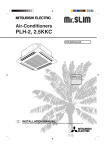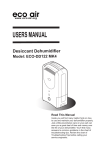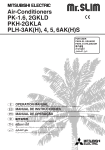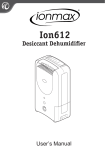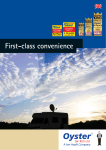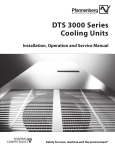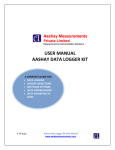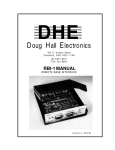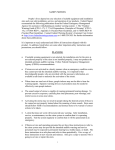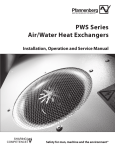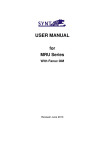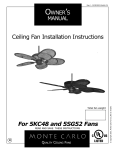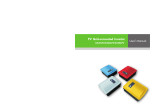Download Mitsubishi 2.5KKC Specifications
Transcript
Air-Conditioners PLH-2, 2.5KKC FOR USER ON/OFF – CENTRALLY CONTROLLED ON OFF CHECK CLOCK 1Hr. ˚C FILTER CHECK MODE STAND BY DEFROST E ˚C TEST RUN NOT AVAILABLE OPERATION MANUAL For safe and correct use, please read this operation manual thoroughly before operating the air-conditioner unit. E Contents 1. Safety Precautions ...................................................................... 2 1.1. Installation ..................................................................... 2 1.2. During operation ............................................................ 4 1.3. Disposing of the unit ...................................................... 5 2. Introduction ................................................................................. 6 3. Components ................................................................................ 6 3.1. Indoor unit and remote controller ................................... 6 3.2. Outdoor unit ................................................................... 7 4. Operation .................................................................................... 7 4.1. Operation modes ........................................................... 7 4.2. Switching the unit on/off ................................................ 8 4.3. Cooling .......................................................................... 8 4.4. Drying (dehumidifying) ................................................... 9 4.5. Heating .......................................................................... 9 4.6. Automatic (cooling / heating) ....................................... 10 4.7. Selecting a temperature .............................................. 10 4.8. Using the timer ............................................................ 11 4.9. Selecting a fan speed .................................................. 13 4.10.Adjusting vertical airflow direction ............................... 14 4.11.Vertical airflow adjustment ........................................... 14 5. Tips for best results ................................................................... 15 6. Care and cleaning ..................................................................... 15 6.1. Cleaning the filters and the indoor unit ........................ 15 6.2. Care and cleaning ....................................................... 16 6.3. End-of-season ............................................................. 17 6.4. Pre-season checks ...................................................... 17 7. Troubleshooting ........................................................................ 18 8. Specifications ............................................................................ 19 E 1. Safety Precautions s Since this unit contains rotating parts and parts which could cause an electric shock,be sure to read all of the “Safety Precautions” before operating the unit. s “Safety Precautions” lists important points about safety. Please be sure to follow them. Symbols used in the text Warning: Describes precautions that should be observed to avoid the risk of injury or death to the user. Caution: Describes precautions that should be observed to prevent damage to the unit. Symbols used in the illustrations : Indicates an action that must be avoided. : Indicates that important instructions must be followed. : Indicates a part which must be grounded. : Indicates that caution should be taken with rotating parts. (This symbol is displayed on the main unit label.) <Color: Yellow> : Indicates the main switch. (This symbol is displayed on the main unit label.) <Color: Blue> Warning: Carefully read the labels affixed to the main unit. 1.1. Installation • • • • 2 Warning: The unit should not be installed by the user. Ask the dealer or an authorized company to install the unit. If the unit is installed improperly, water leakage, electric shock or fire may result. Use only accessories authorized by Mitsubishi Electric and ask your dealer or an authorized company to install them. If accessories are installed improperly, water leakage, electric shock or fire may result. The Installation Manual details the suggested installation method. Any structural alteration necessary for installation must comply with local building code requirements. Never repair the unit or transfer it to another site by yourself. If repair is performed improperly, water leakage, electric shock or fire may result. If you need to have the unit repaired or moved, consult your dealer. E 1. Safety Precautions 1.1. Installation 1) Outdoor unit • • Warning: The outdoor unit must be installed on a stable, level surface, in a place where there is no accumulation of snow, leaves or rubbish. Do not stand on, or place any items on the unit. You may fall down or the item may fall, causing injury. Caution: The outdoor unit should be installed in a location where air and noise emitted by the unit will not disturb the neighbours. 2) Indoor unit Warning: The indoor unit should be securely installed. If the unit is loosely mounted, it may fall, causing injury. 1.1. Installation 3) Remote controller Warning: The remote controller should be installed in such a way that children cannot play with it. 4) Drain hose Caution: Make sure that the drain hose is installed so that drainage can go ahead smoothly. Incorrect installation may result in water leakage, causing damage to furniture. 3 E 1. Safety Precautions 1.1. Installation 5) Power line, fuse or circuit breaker • • • A Warning: Make sure that the unit is powered by a dedicated line. Other appliances connected to the same line could cause an overload. Make sure that there is a main power switch. Be sure to adhere to the unit’s voltage and fuse or circuit breaker ratings. Never use a piece of wire or a fuse with a higher rating than the one specified. A Fuse or circuit breaker B B Main power switch 6) Grounding • • C Caution: The unit must be properly grounded. Never connect the grounding wire to a gas pipe, water pipe, lightning conductor or telephone grounding wire. If the unit is not grounded properly, electric shock may result. Check frequently that the ground wire from the outdoor unit is properly connected to both the unit’s ground terminal and the grounding electrode. C Grounding electrode 1.2. During operation • MITSUBISHI CENTRALL Y CONTROL ON/OFF – LED CHECK ON OFF 1Hr. CLOCK ˚C STAND BY DEFROST FILTER CHECK MODE ˚C NOT AVAILABLE TEST RUN • • • • • 4 Caution: Do not use any sharp object to push the buttons, as this may damage the remote controller. Do not twist or tug on the remote controller cord as this may damage the remote controller and cause malfunction. Never block or cover the indoor or outdoor unit’s intakes or outlets. Tall items of furniture underneath the indoor unit, or bulky items such as large boxes placed close to the outdoor unit will reduce the unit’s efficiency. Warning: Do not splash water over the unit and do not touch the unit with wet hands. An electric shock may result. Do not spray combustible gas close to the unit. Fire may result. Do not place a gas heater or any other open-flame appliance where it will be exposed to the air discharged from the unit. Incomplete combustion may result. E 1. Safety Precautions 1.2. During operation • • • • • • • Warning: Do not remove the front panel or the fan guard from the outdoor unit when it is running. You could be injured if you touch rotating, hot or high-voltage parts. Never insert fingers, sticks etc. into the intakes or outlets, otherwise injury may result, since the fan inside the unit rotates at high speed. Exercise particular care when children are present. If you detect odd smells, stop using the unit, turn off the power switch and consult your dealer. Otherwise, a breakdown, electric shock or fire may result. Do not over-cool. The most suitable inside temperature is one that is within 5°C of the outside temperature. Do not leave handicapped people or infants sitting or standing in the path of the airflow from the air-conditioner. This could cause health problems. Caution: Do not direct the airflow at plants or caged pets. Ventilate the room frequently. If the unit is operated continuously in a closed room for a long period of time, the air will become stale. 1.3. Disposing of the unit Warning: When you need to dispose of the unit, consult your dealer. If pipes are removed incorrectly, refrigerant (fluorocarbon gas) may blow out and come into contact with your skin, causing injury. Releasing refrigerant into the atmosphere also damages the environment. 5 E 2. Introduction E 3. Components This air-conditioner unit is designed for maximum efficiency and ease of use. You can use it to cool, heat or dehumidify a room by making the appropriate settings on the wall-mounted remote controller. Once you have made your settings, operating the unit is usually a matter of simply pressing the POWER ON/OFF button. The automatic cooling/heating mode allows setting of an optimum room temperature to which the air conditioner automatically adjust the room temperature. s After you have read this manual, keep it and the Installation Manual in a safe place for easy reference whenever a question arises. If the unit is going to be operated by another person, make sure that this manual is given to him or her. A Indoor unit B Remote controller A ON/OFF – CENTRALLY CONTROLLED 1Hr. ON OFF CHECK B ˚C CLOCK FILTER CHECK MODE STAND BY DEFROST ˚C TEST RUN NOT AVAILABLE 3.1. Indoor unit and remote controller E The indoor unit is mounted into the ceiling of your room and puts out air (cool, warm or dry) according to the settings you make using the remote controller mounted on the wall. A Air intake: Draws air in a room. B Horizontal air outlet: To be automatically set in the horizontal blowing position in either COOL or DRY mode operation. C Downward air outlet F D Automated vane: Helps circulate air upward and downward or adjusts airflow direction. E Air filter D C B A ON/OFF – CENTRALLY CONTROLLED ON OFF CHECK CLOCK 1Hr. ˚C FILTER CHECK MODE STAND BY DEFROST G 6 ˚C TEST RUN NOT AVAILABLE F Decorative panel G Remote controller E 3. Components E 4. Operation 3.2. Outdoor unit A The outdoor unit takes in and feeds outside air to the indoor unit and exhausts heated air in the cooling or dehumidifying mode, or cool air in the heating mode. A Air outlet B Air intake B PUH-2KA A B PUH-2.5KA 4.1. Operation modes Cooling The air conditioner works to cool the room to the selected temperature. The fan blows air continuously at the selected speed. Drying (dehumidifying) ing mode ON/OFF – CENTRALLY CONTROLLED ON OFF CHECK CLOCK 1Hr. ˚C FILTER CHECK MODE STAND BY DEFROST TEST RUN ˚C : Disabled in the heat- The drying mode efficiently reduces the humidity in the room so that the room temperature is not lowered excessively. When the selected room temperature is reached in the Low setting, the airflow will stop for ten minutes and then will resume for three minutes to keep the humidity low. Heating NOT AVAILABLE • The air conditioner works to heat the room to the selected temperature. • When selecting the heating mode, a desired room temperature must be set to avoid any cool air. The fan will gradually increase the airflow delivery up to a selected rate. • When the room temperature reaches the selected temperature and the compressor stops, the fan will deliver a gentle airflow. CLOCK ON OFF FILTER CHECK TEMP. REMOTE CONTROLLER PAR-JH240KA TIMER SET TEST RUN Automatic (cooling / heating) The air conditioner automatically goes into the cooling or heating mode to keep the room at the selected temperature. 7 E 4. Operation 4.2. Switching the unit on/off s Before pressing the ON/OFF button: • Check to see if the power supply is on. • The power supply should not be turned off while the air conditioner is in use. This can cause the unit to break down. 1 Press the ON/OFF button. ON/OFF – CENTRALLY CONTROLLED 1Hr. ON OFF CHECK A ˚C CLOCK 1 FILTER CHECK MODE TEST RUN ˚C STAND BY DEFROST NOT AVAILABLE CLOCK ON OFF FILTER A The ON indicator should light up. Note: • Even if you press the ON/OFF button immediately after shutting down the operation in progress, the air conditioner will not start for about three minutes. This is to prevent the internal components from being damaged. • If the operation stops due to a power failure, the unit will not automatically restart until the power has been restored. Press the ON/OFF button to restart. CHECK TEMP. TIMER SET TEST RUN REMOTE CONTROLLER PAR-JH240KA 4.3. Cooling 1 If the unit is off, press the ON/OFF button to turn it on. A The ON indicator should light up. 2 Press the operation mode cooling mode . B button and select the should be displayed. 3 If necessary, press TEMP. button to set the desired temperature. See page 10 for details. ON/OFF – CENTRALLY CONTROLLED B ON OFF CHECK CLOCK FILTER ˚C 1 CHECK MODE STAND BY DEFROST TEST RUN ˚C NOT AVAILABLE FILTER CHECK TIMER SET TEST RUN REMOTE CONTROLLER PAR-JH240KA 26 3 8 4 If necessary, press button to select a desired rate. See page 13 for details. 5 If necessary, press to specify the vertical angle at which the air is blowing. See page 14 for details. 6 If necessary, press button to set the timer. See page 11 for details. CLOCK ON OFF TEMP. A 1Hr. 4 5 E 4. Operation 4.4. Drying (dehumidifying) 1 If the unit is off, press the ON/OFF button to turn it on. A The ON indicator should light up. 2 Press the operation mode drying mode . B ON/OFF – CENTRALLY CONTROLLED B ON OFF CHECK FILTER ˚C CLOCK 1 CHECK MODE TEST RUN ˚C STAND BY DEFROST A 1Hr. 2 CHECK TIMER SET TEST RUN REMOTE CONTROLLER PAR-JH240KA 5 3 If necessary, press TEMP. button to set the desired temperature. See page 10 for details. 4 If necessary, press to specify the vertical angle at which the air is blowing. See page 14 for details. Note: • When the room temperature is lower than 18°C, the drying mode cannot be set. • This reduces the operation level of the indoor fan. See page 13 for details. • There may be times when the airflow volume does not match the display on the remote control unit. FILTER TEMP. should be displayed. 5 If necessary, press button to set the timer setting. See page 11 for details. NOT AVAILABLE CLOCK ON OFF 3 button and select the 4 4.5. Heating 1 If the unit is off, press the ON/OFF button to turn it on A The ON indicator should light up. 2 Press the operation mode heating mode . B B ON/OFF – CENTRALLY CONTROLLED ON OFF CHECK C D CLOCK FILTER ˚C 1 CHECK MODE STAND BY DEFROST TEST RUN ˚C NOT AVAILABLE CLOCK ON OFF FILTER 2 CHECK 3 TEMP. A 1Hr. TIMER SET TEST RUN REMOTE CONTROLLER PAR-JH240KA button and select the should be displayed. 3 If necessary, press TEMP. button to set the desired temperature. See page 10 for details. 4 If necessary, press button to select a desired rate. See page 13 for details. 5 If necessary, press to specify the vertical angle at which the air is blowing. See page 14 for details. 6 If necessary, press button to set the timer. See page 11 for details. The fan speed may differ from the set speed at the start of the heating mode, during the defrosting mode, or after shutdown of the heating mode. C “STAND BY” is displayed from the moment heating begins until warm air is blown out. D “DEFROST” is displayed during defrosting. 6 4 5 9 E 4. Operation 4.6. Automatic (cooling / heating) The AUTO mode starts with cooling or heating depending on the current room temperature, higher or lower, than a selected temperature value accordingly. 1 If the unit is off, press the ON/OFF button to turn it on. A The ON indicator should light up. ON/OFF – CENTRALLY CONTROLLED FILTER ˚C CLOCK B 1 CHECK MODE 3 If necessary, press TEMP. button to set the desired temperature. See page 10 for details. 4 If necessary, press button to select a desired rate. See page 13 for details. NOT AVAILABLE CLOCK ON OFF FILTER 2 CHECK 3 should be displayed. TEST RUN ˚C STAND BY DEFROST B button to select the 1Hr. ON OFF CHECK A 2 Press the operation mode automatic mode . TEMP. TIMER SET 5 If necessary, press to specify the vertical angle at which the air is blowing. See page 14 for details. 6 If necessary, press button to set the timer. See page 11 for details. TEST RUN REMOTE CONTROLLER PAR-JH240KA 6 4 5 4.7. Selecting a temperature TEMP. s To decrease the room temperature: 1 Press A • ON/OFF – CENTRALLY CONTROLLED ON OFF CHECK CLOCK button to set the desired temperature. ˚C s To increase the room temperature: TEMP. button to set the desired temperature. A The selected temperature is displayed. FILTER TEST RUN ˚C Each time you press the button, the temperature value decreases by 1°C. 1 Press 1Hr. CHECK MODE STAND BY DEFROST TEMP. A The selected temperature is displayed. • Each time you press the button, the temperature value increases by 1°C. • Available temperature ranges are as follows: NOT AVAILABLE CLOCK ON OFF FILTER CHECK 1 TEMP. REMOTE CONTROLLER PAR-JH240KA 10 TIMER SET TEST RUN Cooling & Drying: Heating: Automatic: Circulation: 19 - 30°C 17 - 28°C 19 - 28°C — (Not available) E 4. Operation 4.8. Using the timer CLOCK ON OFF s Available Timer-Interlocked Operation Modes 1. AUTO START/STOP: Allows both start and shutdown to be interlocked with the timer. A 2. AUTO START: Allows automatic start in response to the timer setting and shutdown to be proceeded by manually pressing the ON/OFF button. ON/OFF – CENTRALLY CONTROLLED 1Hr. ON OFF CHECK ˚C CLOCK FILTER s Timer-interlocked operation is available only once for both start and shutdown in 24 hours. CHECK MODE TEST RUN ˚C STAND BY DEFROST 3. AUTO STOP: Allows the start of the operation to be manually invoked by pressing the ON/OFF button and automatic shutdown based on the timer setting. NOT AVAILABLE s While A is displayed, setting and changing of time for timerinterlocked operation is disabled. CLOCK ON OFF FILTER 1 In this case, press button once to turn off the A display on the remote controller. This is referred to as TIMER OFF operation. CHECK TEMP. TIMER SET TEST RUN REMOTE CONTROLLER PAR-JH240KA 1 4.8. Using the timer CLOCK ON OFF 1) Set the current time 1 Press BA • ˚C CLOCK ON OFF CLOCK → ↑ ON CLOCK → OFF CLOCK → No Display TIMER SET NOT AVAILABLE • Press and hold the button to rapidly change the time. • The time changes in increments of one minute → ten minutes → in units of hour; in this order. • Approximately ten seconds after pressing the button, the display on the remote controller will turn off. CLOCK ON OFF FILTER 1 CHECK TEMP. CLOCK TIMER SET TEST RUN ˚C button to display the “CLOCK” B. Each time you press button, the display on the remote controller cyclically changes as follows. 2 Each time you press button, the time increases in increments of one minute. Each time you press button, the time decreases in increments of one minute . FILTER CHECK MODE STAND BY DEFROST OFF 1Hr. ON OFF CHECK ON Remote controller display A ON/OFF – CENTRALLY CONTROLLED CLOCK TIMER SET TEST RUN REMOTE CONTROLLER PAR-JH240KA 2 11 E 4. Operation 4.8. Using the timer CLOCK ON OFF 2) Set the time to start the unit as follows 1 Press ABC 2 Press CLOCK ON TIMER SET OFF button to display B ON . button to set the time that you want the unit to start. The start time is displayed at A. ON/OFF – CENTRALLY CONTROLLED 1 Press 1Hr. ON OFF CHECK ˚C CLOCK FILTER 2 Press CHECK MODE TEST RUN ˚C STAND BY DEFROST 3) Set the time to stop the unit as follows CLOCK ON TIMER SET OFF button to display C OFF . button to set the time that you want the unit to stop. The stop time is displayed at A. NOT AVAILABLE 4) Changing the set times CLOCK ON OFF FILTER CLOCK 1 CHECK 2 Press TEMP. TIMER SET ON OFF 1 Press button to display the time (CURRENT, START, STOP) you want to change. TIMER SET button to set the desired time. TEST RUN • REMOTE CONTROLLER PAR-JH240KA When change is made to either one of a pair, e.g., AUTO START or AUTO STOP, set the time you need not to change to . This display is available following 23:50. 2 4.8. Using the timer CLOCK ON OFF 5) AUTO START and AUTO STOP operation CLOCK A ON/OFF – CENTRALLY CONTROLLED ˚C CLOCK TEST RUN button to display A on the remote controller. Each time you press button, available options change as follows with relative displays on the remote controller. Remote controller display — Available setting — CHECK TIMER SET REMOTE CONTROLLER PAR-JH240KA 12 The next operation time is displayed after approximately 10 seconds. NOT AVAILABLE FILTER 3 • • CLOCK ON OFF TEMP. For selection or changing of time, see the previous page (page 11). FILTER CHECK MODE ˚C STAND BY DEFROST OFF • 3 Press 1Hr. ON OFF CHECK ON 1 Press button to make the following checks. Check that the current time is correct. Check that the automatic start time is correct. Check that the automatic shutdown time is correct. 1 TEST RUN ↔ A Timer-interlocked operation E 4. Operation CLOCK 4.8. Using the timer ON OFF 6) AUTO START Operation CLOCK CD ON/OFF – CENTRALLY CONTROLLED ˚C CLOCK OFF For the selection of the time, see the previous page (page 11). button once to display C ON on the remote controller. FILTER CHECK MODE 7) AUTO STOP Operation TEST RUN ˚C STAND BY DEFROST • 3 Press 1Hr. ON OFF CHECK ON 1 Press button to make the following checks. Check that the current time is correct. Check that the automatic start time is correct. Check that the automatic shutdown time is identical to the display A . NOT AVAILABLE A CLOCK CLOCK ON OFF FILTER CHECK • TEMP. TIMER SET TEST RUN ON OFF 1 Press button to make the following checks. Check that the current time is correct. Check that the automatic shutdown time is correct. Check that the automatic start time is identical to the display A . For the selection of the time, see the previous page (page 11). 3 Press button to display D OFF on the remote controller. REMOTE CONTROLLER PAR-JH240KA 3 1 4.9. Selecting a fan speed 1 Press • button to select a desired fan speed. Each time you press the button, available options change with the display A on the remote controller, as shown below. A Display Available Option (Fan Speed Switch) ON/OFF – CENTRALLY CONTROLLED ˚C CLOCK TEST RUN ˚C High FILTER CHECK MODE STAND BY DEFROST - 1Hr. ON OFF CHECK Low NOT AVAILABLE • In the drying mode • In the heating mode , the indoor fan continues running for approximately one minute to discharge any residual heat from the electric heater; even after the operation has shut down. , the selection of the fan speed is disabled. CLOCK ON OFF FILTER CHECK TEMP. TIMER SET TEST RUN REMOTE CONTROLLER PAR-JH240KA 1 13 4. Operation E 4.10. Adjusting vertical airflow direction A B C D E The vertical air vane helps select the vertical direction of the airflow. 1 Press • →A ↓ B ↓ C ↓ D ↓ E F ON/OFF – CENTRALLY CONTROLLED TIMER SET Downward airflow at an angle of 55° Downward airflow at an angle of 70° When you have selected gentle or cooling mode, or you have entered the drying mode,the available options change in the following order : A→B→D→E→A FILTER • One hour after you have selected D or E, the airflow automatically changes to A and the display F “1HR” appears. CHECK • Do not use D or E too often with the Low airflow option in the cooling and drying modes or condensation can occur. NOT AVAILABLE CLOCK ON OFF TEMP. Downward airflow at an angle of 45° • FILTER TEST RUN ˚C Horizontal airflow 30° Immediately after the power-on sequence, the unit is automatically provided with the initial settings listed below. In the cooling/drying modes: Horizontal airflow In the heating mode: Downward airflow (70°) CHECK MODE STAND BY DEFROST Swing • 1Hr. ˚C CHECK button to select the vertical airflow direction. Each time you press the button, the option changes are displayed on the remote controller, as shown below. TEST RUN REMOTE CONTROLLER PAR-JH240KA 1 4.11. Vertical airflow adjustment Setting this to “Swing” moves the automated vane back and forth within the swing range, so that the air is directed upwards and downwards. In the SWING mode, the remote controller displays a moving arrow as shown in the diagram to indicate the swinging automated vane. The arrow motion on the remote controller display and the actual automated vane movement do not match with each other. In the COOL or FAN mode operation, the vane is set in the ‘fluctuating’ mode, varying airflow rate automatically. When you set OFF the LOUVER switch, the automated vane will return to the position before the SWING mode has been selected. When you toggle the MODE SELECT buttons between COOL, DRY and FAN with the LOUVER switch set OFF, the airflow is set to approx. 30 degrees-horizontal blowing in the COOL or electronics DRY mode while to approx. 70 degrees-downward blowing in the FAN mode. 30˚ A B C 70˚ 14 A Horizontal air outlet B Downward air outlet C Swing range <30 degrees to 70 degrees> ;;;; ; ; E 5. Tips for best results E 6. Care and cleaning Keep the filters clean Dirty or clogged filters reduce the flow of air, making the unit less efficient. Very dirty filters may even cause damage to the unit. Remove and clean the filters at least once a week (more often, in very dusty locations). Using a vacuum cleaner is an ideal way to clean the filters. Let fresh air into the room from time to time Open the windows and ventilate the room now and then, otherwise the room will become musty. Eliminate heat sources When cooling the room, draw the curtains to keep out direct sunlight. Keep doors and windows fully closed, and avoid opening doors more often than necessary. Do not over-cool The air-conditioner works most efficiently when cooling the room to a temperature within 5˚C of the outdoor temperature. In COOL mode, for every 1˚C you increase the desired temperature setting, you will save about 10% on electricity costs. ■ PLP-2.5KC • B A • Caution: Always turn off the power, first on the remote controller and then the main switch, before cleaning or servicing the unit. When installing or removing the filter or front panel, do not stand on an unsteady surface. You may fall and injure yourself. Be also careful not to let dust fall into your eyes. 6.1. Cleaning the filters and the indoor unit C Dirty or clogged filters block the airflow and reduce efficiency. Very dirty filters can damage the air-conditioner itself. Filter removal ■ PLP-2.5KC 1 Pull the knob on the intake grille in the direction indicated by the arrow and it should open. 2 Open the intake grille. 3 Release the knob on the center edge of the intake grille and pull the filter forward to remove the filter. D ■ PLP-2.5KB B C A1 D 2 A B C D Knob Grille Intake grille Filter ■ PLP-2.5KB 1 Pressing the PUSH button on the outer side of the intake grille causes the intake grille to open automatically. 2 A filter with an intake grille on it can be removed by pulling the filter forward. A B C D Knob Grille Intake grille Filter 15 E 6. Care and cleaning 6.1. Cleaning the filters and the indoor unit Cleaning the filters • Clean the filters using a vacuum cleaner. If you do not have a vacuum cleaner, tap the filters against a solid object to knock off dirt and dust. • If the filters are especially dirty, wash them in lukewarm water. Take care to rinse off any detergent thoroughly and allow the filters to dry completely before putting them back into the unit. • • • Cleaning the indoor unit ON/OFF – CENTRALLY CONTROLLED 1Hr. ON OFF CHECK ˚C CLOCK FILTER CHECK MODE STAND BY DEFROST ˚C Caution: Do not dry the filters in direct sunlight or by using a heat source, such as an electric heater: this may warp them. Do not wash the filters in hot water (above 50°C), as this may warp them. Make sure that the air filters are always installed. Operating the unit without air filters can cause malfunction. TEST RUN NOT AVAILABLE • Wipe the outside of the unit with a clean, dry, soft cloth. • Clean off any oil stains or finger marks using a neutral household detergent (such as dishwashing liquid or laundry detergent). Caution: Never use gasoline, benzene, thinner, scouring powder or any type of non-neutral detergent, as these substances may damage the unit’s case. 6.2. Care and cleaning Clean the filter When the A “FILTER” indicator blinks on the remote controller to alert you to the necessity of cleaning of the filter. A ∗ Reset the FILTER indicator ON/OFF – CENTRALLY CONTROLLED ON OFF CHECK CLOCK 1Hr. ˚C 1 Press the FILTER button twice after cleaning. FILTER CHECK MODE STAND BY DEFROST s When you press the FILTER button twice, the ‘FILTER’ indicator A will be turned off and reset. TEST RUN ˚C NOT AVAILABLE CLOCK ON OFF FILTER 1 CHECK TEMP. REMOTE CONTROLLER PAR-JH240KA 16 TIMER SET As a guideline for typical office environment, the long-life filter must be cleaned every 2,500 operating hours. TEST RUN s The FILTER indicator provides you with a guideline for the necessity of filter cleaning based on total operating hours in typical indoor air conditions. Depending on different operating environments, more or less frequent cleaning may be necessary. E 6. Care and cleaning 6.3. End-of-season s Press POWER ON/OFF to turn the unit off. s Turn off the main power switch. s Clean the filters and the indoor unit thoroughly. s Clean the outdoor unit and place a protective cover over it to keep out dirt and rubbish. ON/OFF – CENTRALLY CONTROLLED ON OFF CHECK CLOCK 1Hr. ˚C FILTER CHECK MODE STAND BY DEFROST ˚C TEST RUN NOT AVAILABLE ;;;;; ;;;;; ;;;;; 6.4. Pre-season checks s Remove the protective cover from the outdoor unit. s Check that the outdoor unit is properly installed. s Check that the outdoor unit’s ground wire is properly attached. s Check that the intakes and outlets on both the indoor and outdoor units are free of any obstruction. s Check that the drain hose is not blocked, that there are no kinks in it, and that it is correctly installed. s Check that the filters are installed in the indoor unit. Operating the air-conditioner without filters can damage it. Caution: The first time you use the air-conditioner after a long break (e.g. the first hot day of summer), turn on the main power at least twelve hours before you turn on the unit using the POWER ON/OFF button. This will assist trouble-free operation. 17 E 7. Troubleshooting Before you call out a repair man, check the following table to see whether there is a simple solution to your problem. Problem Unit will not start. Display reading Pilot lamp does not turn on even when the POWER ON/OFF button is pressed. Unit discharges air well, but fails to Remote controller shows that the unit is operating. cool or heat the room well. Cause Main power switch is turned off. Solution Turn main power on. Then press the POWER ON/OFF button to turn the unit on. Main power fuse has blown. Outdoor unit’s ground fault breaker is open. A power cut has occurred (see NOTE below). Replace the fuse. Reset the ground fault breaker. Improper temperature setting - e.g. you have selected COOL mode, but the desired temperature setting is higher than the current room temperature. Check the set temperature on the remote controller and the actual intake air temperature. Use the COOLER and WARMER buttons to set the temperature as described in “Selecting a temperature” on page 10. Clean the filter and resume operation. See “Cleaning the filters and the indoor unit” on page 15. Remove the obstruction. Filters are clogged. Outdoor unit’s intake or outlet is obstructed. Wait until power is restored, then press the POWER ON/OFF button to turn the unit on. A door or window has been left open. Shut door or window. Unit does not start immediately. Remote controller shows that the unit is operating. Unit is waiting three minutes before Wait until the unit restarts automatirestarting. cally. The compressor may hesitate resuming because a three-minute resume prevention circuit is incorporated in the outdoor unit for protection of the compressor. Unit stops soon after starting. Remote controller check display reads “CHECK P6” or “CHECK P8”. Indoor or outdoor unit’s intake or outlet is obstructed. Filters are clogged. NOTE: Remove obstruction and restart the unit. Remove the obstruction. Clean the filter and resume operation. See “Cleaning the filters and the indoor unit” on page 15. After a power cut, the unit will not restart automatically. You will have to restart it by pressing the POWER - ON/OFF button on the remote controller. If none of the above apply, turn the main switch off and contact the dealer from whom you bought the air-conditioner, telling him the model name and the nature of the problem. Do not try to fix the unit yourself. In any of the following cases, turn off the main power switch and contact your local dealer for service: • “CHECK” followed by “P1”, “P2”, “P3”, “P4”, “P5”, “P7” or “CENTRALLY CONTROLLED” is displayed on the control panel. • The switches do not work properly. • The circuit breaker trips frequently (or the fuse blows frequently). • Water has accidentally been splashed into the unit. • Water leaks from the unit. • Something is accidentally dropped into the air-conditioner. • An unusual noise is heard during operation. The following do not indicate any malfunction: Odours: smells such as tobacco or cosmetic odours may persist after they have been sucked into the unit. Sound of liquid flowing inside indoor unit: this can occur during or after operation and is simply the sound of refrigerant being circulated inside the unit. Ticking sound coming from indoor unit: this can occur when cooling or heating has just begun or has just stopped. It is caused by the indoor unit shrinking or expanding slightly due to the change in temperature. The message “CENTRALLY CONTROLLED” appearing on the LCD panel: from time to time, this message may come up on the LCD panel. This does not indicate any malfunction. Warning: If the air conditioner operates but does not cool or heat (depending on model) the room, consult your dealer since there may be a refrigerant leak. Be sure to ask the service representative whether there is refrigerant leakage or not when repairs are carried out. The refrigerant charged in the air conditioner is safe. Refrigerant normally does not leak, however, if refrigerant gas leaks indoors, and comes into contact with the fire of a fan heater, space heater, stove, etc., harmful substances will be generated. 18 8. Specifications Model W BTU/h kW W BTU/h kW Grille Indoor unit Item Performance *4 E Cooling*2 capacity Total input Heating*3 capacity Total input Model name Power supply*1 Air flow (Lo-Hi) Fan Noise level (Lo-Hi) Motor output Booster heater Dimensions (H × W × D) Weight Dimensions (H × W × D) Weight Model name CMM dB (A) kW kW mm kg mm kg PLH-2KKC 5350 18300 2.32 6000 20500 2.29 PLH-2KKC ~ (1ph), 240V, 50Hz 13 - 16 32 - 37 0.030 – 253 × 660 × 660 19 30 × 760 × 760 3.7 PUH-2AKA PLH-2.5KKC 6200 21200 2.54 6900 23500 2.30 PLH-2.5KKC ~ (1ph), 240V, 50Hz 14 - 17 35 - 39.5 0.030 – 253 × 660 × 660 20 30 × 760 × 760 3.7 PUH-2.5AKA ~ (1ph) 240V 50Hz ~ (1ph) 240V 50Hz 45 0.065 1.7 38 650 × 870 × 295 64 49 50 0.085 2.0 38 850 × 870 × 295 68 52 Outdoor unit Power supply*1 Air flow CMM Motor output kW Compressor motor output kW Crankcase heater W Dimensions (H × W × D) mm Weight kg Noise level dB (A) Fan Notes: *1 Refer to the product nameplate attached to the unit for the electrical specifications. *2 Rating conditions (cooling) Indoor : 27°C DB, 19°C WB Outdoor : 35°C DB *3 Rating conditions (heating) Indoor : 21°C DB Outdoor : 7°C DB, 6°C WB *4 These data based on indicated voltage. 1ph, 240V *5 Specifications subject to change without notice. Operating range Cooling Heating Maximum Minimum Maximum Minimum Indoor air intake temperature 35°C DB, 22.5°C WB 21°C DB, 15.5°C WB 27°C DB 20°C DB Outdoor air intake temperature 46°C DB –5°C DB 21°C DB, 15.5°C WB –8.5°C DB, –9.5°C WB Units should be installed by licensed electric contractor accordingly to local code requirement. 19 HEAD OFFICE: MITSUBISHI DENKI BLDG., 2-2-3, MARUNOUCHI, CHIYODA-KU, TOKYO 100-8310, JAPAN BG79S987H02 Printed in Japan




















